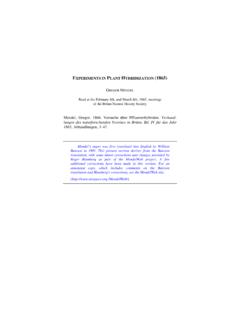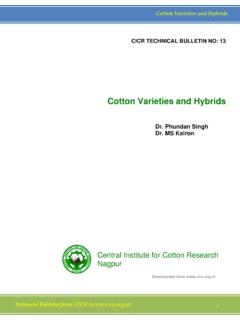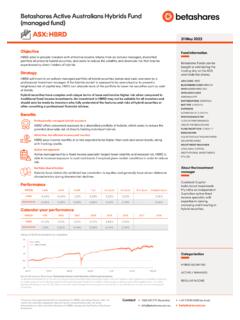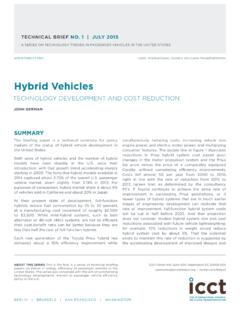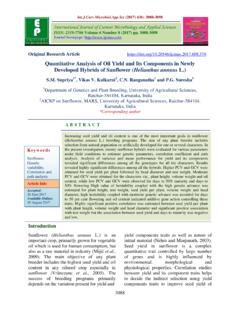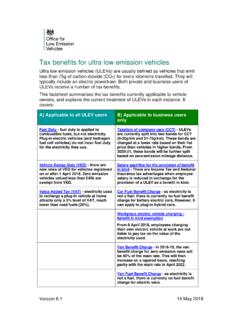Transcription of EPA test procedure for EVs-PHEVs-11-14-2017
1 [1] EPA Test Procedures for Electric Vehicles and Plug-in Hybrids DRAFT Summary Regulations take Precedence D. Good November 14, 2017 Note: FE Label format requirements have been revised in the 2013 fuel economy Labeling Rulemaking, (final rule 76 FR 39478, July 6, 2011) 1. Electric Vehicle Test procedure - In general, EPA testing follows SAE Recommended Practice J1634 Issued May 1993, "Electric Vehicle Energy Consumption and Range Test procedure " or SAE Recommended Practice J1634 October 2012, "Battery Electric Vehicle Energy Consumption and Range Test procedure ." These test procedures (as the titles imply) are basically dynamometer test procedures used to measure the energy consumption and driving range of an electric vehicle. The SAE J1634 October 2012 test procedure is commonly referred to as the Multi-Cycle Test (MCT) test procedure .
2 Electric Vehicle - Single-Cycle City Test procedure Summary - Following SAE J1634 May 1993 Recommended Practice, the battery is fully charged, the vehicle is parked overnight, and then the following day the vehicle is driven over successive city cycles until the battery becomes discharged (and the vehicle can no longer follow the city driving cycle). After running the successive city cycles, the battery is recharged from a normal AC source and the energy consumption of the vehicle is determined (in kW-hr/mile or kW-hr/100 miles) by dividing the kilowatt-hours of energy to recharge the battery by the miles traveled by the vehicle. The recharge energy includes any losses due to inefficiencies of the manufacturer s charger. To calculate the energy consumption in units of mpge (miles/gallon equivalent) we use a conversion factor of kilowatt-hours of electricity per gallon of gasoline (which is basically a measure of the energy in gasoline (in BTUs) converted to electricity).
3 The city driving range is determined from the number of miles driven over the city cycle until the vehicle can no longer follow the driving cycle. Electric Vehicle Single-Cycle Highway Test procedure Summary - The same SAE J1634 May 1993 test procedure outlined above, is used to determine the highway energy consumption and the highway driving range (except the vehicle is operated over successive highway cycles). Electric Vehicle Multi-Cycle City/Highway Test procedure Summary Following SAE J1634 October 2012 Recommended Practice, the battery is fully charged, the vehicle is parked overnight, and then the following day the vehicle driven over successive city (UDDS), highway and steady-state cycles until the battery becomes discharged (and the vehicle can no longer follow the driving cycle).
4 DC discharge energy and DC discharge amp-hours are measured for the entire test. After the testing is completed, the battery is then recharged from a normal AC source using the manufacturer s charger for that vehicle. The energy consumption of the city and highway cycles (in kW-hr/mile or kW-hr/100 miles) are then determined mathematically from the recharging energy, the DC discharge data and distance for each cycle. The recharge energy includes any losses due to inefficiencies of the manufacturer s charger. Electric Vehicle - Adjustment procedure used to Derive FE Label (Window Sticker) Estimates - EPA regulations require fuel economy , energy consumption, CO2 and driving range values listed on the FE Label (window sticker) to be adjusted to more accurately reflect the values that customers can expect to achieve in the real world.
5 EPA currently allows fuel economy , energy consumption, CO2 values, and range values listed on the FE Label (window sticker) for electric vehicles to be adjusted using one of the following methods:1 1 Based on the provisions of 40 CFR (a)(6) and 40 CFR (d)(3). [2] by multiplying city/highway fuel economy and range values by and dividing city/highway energy consumption and CO2 values by ; using the derived 5-cycle method described in 40 CFR (a)(2) and EPA guidance letter CD-15-15, June 22, 2015 (available at ); using a method which is equivalent to the vehicle specific 5-cycle method described in 40 CFR (a)(1) (with prior EPA approval) such as the method provided in Appendix B of SAE J1634 July 2017 Recommended Practice; using adjustment factors which are based on in-use data (with prior EPA approval).
6 Currently, most EVs use the first or third method (the factor). 2. Plug-in hybrid Vehicle (PHEV) Test procedure - EPA testing follows SAE Recommended Practice J1711, June 2010, ""Recommended Practice for Measuring the Exhaust Emissions and fuel economy of hybrid -Electric Vehicles, Including Plug-in hybrid Vehicles," with some exceptions. PHEV - Charge-Depleting Operation - For the electric portion of PHEV operation (commonly called charge-depleting mode of operation), EPA testing follows SAE Recommended Practice J1711, which is essentially the same single-cycle test procedure as used for electric vehicles. The charge depleting test for PHEVs starts with a fully charged battery and ends when the battery is discharged. If the gasoline engine operates during the charge depleting mode, both the electric energy consumption and the gasoline consumption are used to calculate the mpge values for the charge depleting (mostly electric) operation.
7 PHEV - Charge-Sustaining Operation - For the gasoline portion of PHEV operation (commonly called charge-sustaining mode of operation), EPA tests the vehicle similar to any other conventional hybrid vehicle---using either the derived 5-cycle (city/highway) method or the vehicle specific 5-cycle (city/highway/US06/SC03/Cold temperature test) method. The charge-sustaining test for PHEVs starts with a discharged battery. Note that for the city test, EPA conducts a 4-bag city test similar to the test procedure required for any conventional hybrid vehicle. PHEV - Adjustment procedure used to Derive City & Highway FE Label (Window Sticker) Estimates - EPA regulations require the city and highway energy consumption and driving range values listed on the FE Label (window sticker) to be adjusted to more accurately reflect the energy consumption and driving range that customers can expect to achieve in the real world.
8 For PHEVs operating in the charge-depleting mode, one of the adjustment procedures is used as described (above) for electric vehicles, except that the adjustment procedures described in the third and fourth bullets are not applicable to PHEVs. For PHEVs operating in the charge-sustaining mode, the adjustment procedure is similar to any other conventional vehicle---the dynamometer test values are adjusted using either the derived 5-cycle (city/highway) method described in 40 CFR (a)(2)(i) and(a)(2)(ii) and EPA guidance letter CD-15-15, June 22, 2015; or the vehicle specific 5-cycle (city/highway/US06/SC03/Cold temperature test) method described in 40 CFR 3. EPA Confirmatory testing - Currently, EPA performs confirmatory testing on all new light-duty electric vehicles and plug-in hybrid vehicles at EPA's emission testing laboratory in Ann Arbor Michigan.
9 If the manufacturer makes changes to an EV or PHEV that was previously tested at EPA, EPA will decide on a case-by-case basis whether additional EPA confirmatory testing is needed.



